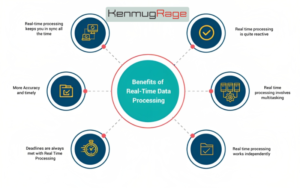” Decoding Data For Success: Navigating Business Trends With Analytics”
It’s no secret that analytics are essential to the success of any business. In this blog post, we’ll explore how businesses can crack data and use analytics to navigate trends and reach their goals.
We will bandy the significance of data collection, association, and analysis in the moment’s data- driven world, and give tips on how to use analytics to make informed opinions and ameliorate your business performance. By the end of this post, you will be armed with the necessary tools to unleash the value of data for your business.
1.Why Data is crucial for Business Success 
Data is pivotal for business success because it provides precious perceptivity and helps inform decision- making processes. In the moment’s presto- paced, data- driven world, businesses that work with data have a significant competitive advantage. This is why data is so pivotal for business success.
First and foremost, data allows businesses to understand their guests more. By collecting and assaying client data, businesses can gain perceptivity into client preferences, actions, and purchasing patterns.This information is inestimable in developing effective marketing strategies, targeting the right followership, and bodying the client experience.
With data, businesses can identify their most profitable client parts and knitter their products or services to meet their requirements. Likewise, data enables businesses to make informed opinions grounded on substantiation rather than suspicion or guesswork. Rather than counting on gut passions, data- driven decision- making allows businesses to back their choices with solid substantiation and objective perceptivity.
This reduces the threat of making expensive miscalculations and increases the chances of success. Data also helps businesses identify trends and prognosticate unborn issues. By assaying literal data, businesses can spot patterns and identify trends that may impact their assiduity. This allows them to stay ahead of the competition and acclimatise their strategies consequently. For illustration, retailers can use deals data to prognosticate peak shopping seasons and acclimate their force situations to meet client demand.
2.The significance of Analytics in Navigating Business Trends 
Analytics play a pivotal part in navigating business trends and staying ahead of the competition. In the moment’s fleetly evolving business geography, trends can crop and change in the blink of an eye. By exercising analytics, businesses can gain a deeper understanding of these trends, identify openings, and make informed opinions to drive their success.
One of the crucial benefits of analytics in navigating business trends is the capability to describe patterns and trends in data. By assaying large datasets, businesses can identify correlations, uncover retired perceptivity, and prognosticate unborn trends.
For illustration, ane-commerce retailer can use analytics to track client browsing and purchasing to identify popular products and anticipate demand. This allows the retailer to stock over on popular particulars and knitter their marketing strategies consequently. Another pivotal aspect of analytics is the capability to cover and measure the effectiveness of business strategies and enterprise.
By setting up crucial performance pointers( KPIs) and tracking applicable criteria , businesses can gauge the success of their sweats and make necessary adaptations.For example, a marketing platoon can use analytics to track website business, conversion rates, and client engagement criteria to estimate the effectiveness of their juggernauts and optimise their strategies. Likewise, analytics can help businesses identify arising trends and acclimatise their strategies consequently.
By assaying request data and monitoring assiduity trends, businesses can proactively identify shifts in consumer preferences, technological advancements, and competitive geographies. This allows them to stay ahead of the wind and make nimble opinions to subsidise on arising openings. Also, analytics enables businesses to enhance their client experience by bodying immolations and perfecting client satisfaction.
3.Different Types of Data and How to Use Them 
Different Types of Data and How to Use Them When it comes to exercising data for business success, it’s important to understand the different types of data available and how each can be effectively used. Then, we’ll explore the colourful types of data and give perceptivity into how they can be employed to drive business growth and achieve your goals.
- client Data: client data is at the heart of understanding your target followership and delivering substantiated guests . This type of data includes demographic information, purchase history, browsing, and feedback. By assaying client data, businesses can identify trends, preferences, and patterns, allowing them to conform marketing juggernauts, ameliorate client satisfaction, and optimise their immolations. Using client data also enables businesses to member their client base, relating high- value guests and developing strategies to retain and engage them.
- Functional Data: functional data refers to internal data generated by business operations. This includes data on deals, force situations, product processes, and hand performance. assaying functional data helps identify backups, inefficiencies, and openings for enhancement. For illustration, by assaying deals data, businesses can identify the most profitable products or services and make data- driven opinions to optimise their immolations. By assaying hand performance data, businesses can identify training requirements and enhance productivity.
- Social Media Data: Social media data is a treasure trove of perceptivity about consumer and brand sentiment. assaying social media data allows businesses to track client engagement, brand mentions, and client sentiment. This data can be used to measure the effectiveness of marketing juggernauts, identify influencers, and understand client preferences. By exercising social media data, businesses can also identify rising trends, cover contender conditioning, and make strategic opinions to stay ahead of the wind.
- Financial Data: Financial data provides critical perceptivity into the fiscal health and performance of a business. This includes profit, charges, cash inflow, and profitability criteria . assaying fiscal data helps businesses cover their fiscal performance, identify areas of enhancement, and make data- driven fiscal opinions. By understanding their fiscal data, businesses can make informed opinions regarding pricing, cost optimization, and investment strategies. To effectively use these types of data, businesses need robust data collection processes, advanced analytics tools, and professed data judges. By investing in data collection and analysis capabilities, businesses can unleash the true eventuality of their data and drive growth, profitability, and competitive advantage.
4.Best Practices for Collecting, Analysing, and Acting on Data
In order to effectively harness the power of data, businesses must apply stylish practices for collecting, assaying, and acting on data. These practices are essential for maximising the value of data and driving business success. Then there are some stylish practices to consider.
- Define clear objectives: Before collecting and assaying data, it’s important to define clear objects. What are you hoping to achieve with the data? What specific perceptivity are you looking for? By having a clear purpose in mind, you can ensure that your data collection and analysis are aligned with your goals.
- Collect applicable and accurate data :When collecting data, it’s pivotal to concentrate on gathering information that’s applicable to your objects. Avoid collecting inordinate data that you do not need, as this can make analysis more complex and time- consuming. also, ensure that the data you collect is accurate and dependable. apply proper data confirmation processes and double- check the quality of the data to avoid making opinions grounded on inaccurate information.
- Use applicable analytics tools :The choice of analytics tools can greatly impact the effectiveness of your analysis. Consider the specific requirements of your business and choose tools that align with your objects. There are multitudinous analytics tools available, ranging from introductory spreadsheets to advanced machine learning algorithms. estimate the features, capabilities, and costs of different tools to find the stylish fit for your business.
5.Common mistakes to Avoid When Using Analytics in Business 
Using analytics in business can be incredibly important, but it’s important to avoid common miscalculations that can hamper your progress and undermine the value of your data. Then are some crucial miscalculations to avoid when using analytics in business
- Ignoring the mortal element :While data and analytics give precious perceptivity, it’s important not to overlook the mortal element. Data should be used as a tool to support decision- timber, but it should noway replace critical thinking and moral judgement. Flash back to consider the environment, nuances, and limitations of the data before making any conclusions or opinions.
- Focusing solely on quantitative data: While quantitative data, similar to deals figures and website analytics, are essential for understanding business performance, it’s important to also consider qualitative data. Qualitative data provides rich perceptivity into client feedback, opinions, and guests . By incorporating qualitative data through checks, interviews, and client feedback, businesses can gain a deeper understanding of client requirements and preferences.
- Overlooking data quality and accuracy: One of the most common miscalculations businesses make is neglecting data quality and delicacy. Using data that’s deficient, outdated, or inaccurate can lead to defective analysis and deceived decision- timber. It’s essential to invest in data quality operation, including data confirmation processes and regular data cleaning, to ensure the integrity of your data.
- Failing to communicate and visualise data effectively: Data analysis is only precious if it can be understood and communicated effectively. Avoid overwhelming your followership with complex maps and slang. rather, concentrate on presenting data in a clear and visually charming manner that highlights crucial perceptivity and trends. This will help ensure that your data is fluently digestible and practicable.
- Lack of alignment with business objectives: Data analysis should always be aligned with your business objects. It’s easy to get lost in the ocean of available data and lose sight of what truly matters for your business. Before diving into data analysis, easily define your objects and the specific perceptivity you’re seeking. This will help guide your analysis and ensure that you’re fastening on the data that’s utmost applicable to your goals.
By avoiding these common miscalculations, you can ensure that your use of analytics in business is effective and precious. Flash back that analytics is an important tool that can drive informed decision- timber and business success, but it’s important to approach it with caution and careful consideration.
Conclusion:
In the moment’s data- driven world, analytics has become a necessary tool for businesses to navigate trends and achieve success. By employing the power of data, businesses can gain precious perceptivity, make informed opinions, and drive their strategies forward. Throughout this blog post, we’ve explored the significance of data collection, association, and analysis, as well as the different types of data and stylish practices for exercising them.
Also Read : ” Instant Insight: Exploring The World Of Real- Time Computing”
Also Read : 5 Essential Tips for Enhancing Nightclub Safety with Advanced ID Scanners




